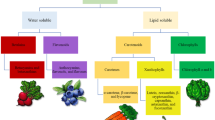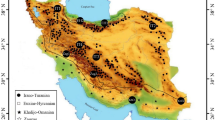Abstract
In this study, the aroma components of bead-shaped green teas were compared through headspace solid-phase microextraction (HS-SPME) and gas chromatography–mass spectrometry/olfactometry (GC–MS/O) coupled with chemometrics. A total of 62 volatile compounds were identified in 16 green tea samples. Notably, comparison of GC–MS/O and odour activity values (OAV) results revealed that nonanal, decanal, (E)-2-nonenal, β-ionone, and 1-octen-3-one were the most powerful aroma-active compounds that contributed to the aroma profile of the bead-shaped green teas. Furthermore, multivariate statistical techniques (such as principal component analysis, partial least squares-discriminant analysis, and hierarchical cluster analysis) were used to characterise the bead-shaped green teas according to their geographical origin and the flavour characteristics of their volatile compounds. Additionally, the variable importance in the projection method was used to identify 20 volatile markers that could successfully distinguish bead-shaped green teas on the basis of three flavour characteristics. The results of the analysis revealed that HS-SPME and GC–MS/O coupled with chemometrics can provide an effective method for characterising and classifying bead-shaped green teas.




Similar content being viewed by others
References
Qin Z, Pang X, Chen D, Cheng H, Hu X, Wu J (2013) Evaluation of Chinese tea by the electronic nose and gas chromatography–mass spectrometry: correlation with sensory properties and classification according to grade level. Food Res Int 53(2):864–874
Wang C, Lv S, Wu Y, Lian M, Gao X, Meng Q (2016) Study of aroma formation and transformation during the manufacturing process of Biluochun green tea in Yunnan Province by HS-SPME and GC-MS. J Sci Food Agric 96(13):4492–4498
Han ZX, Rana MM, Liu GF, Gao MJ, Li DX, Wu FG, Wei S (2016) Green tea flavour determinants and their changes over manufacturing processes. Food Chem 212:739–748
Hayashi N, Chen R, Ikezaki H, Ujihara T (2008) Evaluation of the umami taste intensity of green tea by a taste sensor. J Agric Food Chem 56(16):7384–7387
Xu YQ, Zhang YN, Chen JX, Wang F, Du QZ, Yin JF (2018) Quantitative analyses of the bitterness and astringency of catechins from green tea. Food Chem 258:16–24
Yang Y, Zhang M, Yin H, Deng Y, Jiang Y, Yuan H, Dong C, Li J, Hua J, Wang J (2018) Rapid profiling of volatile compounds in green teas using Micro-Chamber/Thermal Extractor combined with thermal desorption coupled to gas chromatography-mass spectrometry followed by multivariate statistical analysis. LWT 96:42–50
Zheng XQ, Li QS, Xiang LP, Liang YR (2016) Recent advances in volatiles of teas. Molecules 21(3):338
Feng Z, Li Y, Li M, Wang Y, Zhang L, Wan X, Yang X (2019) Tea aroma formation from six model manufacturing processes. Food Chem 285:347–354
Wang MQ, Ma WJ, Shi J, Zhu Y, Lin Z, Lv HP (2020) Characterization of the key aroma compounds in Longjing tea using stir bar sorptive extraction (SBSE) combined with gas chromatography-mass spectrometry (GC–MS), gas chromatography-olfactometry (GC-O), odor activity value (OAV), and aroma recombination. Food Res Int 130:108908
Lau H, Liu SQ, Xu YQ, Lassabliere B, Sun J, Yu B (2018) Characterising volatiles in tea (Camellia sinensis). Part I: comparison of headspace-solid phase microextraction and solvent assisted flavour evaporation. LWT 94:178–189
Xu YQ, Liu PP, Shi J, Gao Y, Wang QS, Yin JF (2018) Quality development and main chemical components of Tieguanyin oolong teas processed from different parts of fresh shoots. Food Chem 249:176–183
Liu PP, Yin JF, Chen GS, Wang F, Xu YQ (2018) Flavor characteristics and chemical compositions of oolong tea processed using different semi-fermentation times. J Food Sci Technol 55(3):1185–1195
Lv SD, Wu YS, Song YZ, Zhou JS, Lian M, Wang C, Liu L, Meng QX (2015) Multivariate analysis based on GC-MS fingerprint and volatile composition for the quality evaluation of Pu-erh green tea. Food Anal Methods 8(2):321–333
Yang YQ, Yin HX, Yuan HB, Jiang YW, Dong CW, Deng YL (2018) Characterization of the volatile components in green tea by IRAE-HS-SPME/GC-MS combined with multivariate analysis. PLoS ONE 13(3):e0193393
Jing J, Shi Y, Zhang Q, Wang J, Ruan J (2017) Prediction of Chinese green tea ranking by metabolite profiling using ultra-performance liquid chromatography–quadrupole time-of-flight mass spectrometry (UPLC–Q-TOF/MS). Food Chem 221:311–316
Meng W, Xu X, Cheng KK, Xu J, Shen G, Wu Z, Dong J (2017) Geographical origin discrimination of oolong tea (TieGuanYin, Camellia sinensis (L.) O. Kuntze) using proton nuclear magnetic resonance spectroscopy and near-infrared spectroscopy. Food Anal Methods 10(11):3508–3522
Alasalvar C, Topal B, Serpen A, Bahar B, Pelvan E, Gökmen V (2012) Flavor characteristics of seven grades of black tea produced in Turkey. J Agric Food Chem 60(25):6323–6332
General Administration of Quality Supervision, Inspection and Quarantine (AQSIQ) and the Standardization Administration of China (SAC) (2018) Methodology of sensory evaluation of tea, GB/T 23776–2018. China Standard Publishing House, Beijing (in Chinese)
General Administration of Quality Supervision, Inspection and Quarantine (AQSIQ) and the Standardization Administration of China (SAC) (2017) Tea vocabulary for sensory evaluation, GB/T 14487–2017. China Standard Publishing House, Beijing (in Chinese)
Zhu J, Chen F, Wang L, Niu Y, Yu D, Shu C et al (2015) Comparison of aroma-active volatiles in oolong tea infusions using GC-olfactometry, GC-FPD, and GC-MS. J Agric Food Chem 63(34):7499–7510
Kim Y, Lee KG, Kim MK (2016) Volatile and non-volatile compounds in green tea affected in harvesting time and their correlation to consumer preference. J Food Sci Technol 53(10):3735–3743
Kebede BT, Grauwet T, Mutsokoti L, Palmers S, Vervoort L, Hendrickx M, Van Loey A (2014) Comparing the impact of high pressure high temperature and thermal sterilization on the volatile fingerprint of onion, potato, pumpkin and red beet. Food Res Int 56:218–225
Qu F, Zhu X, Ai Z, Ai Y, Qiu F, Ni D (2019) Effect of different drying methods on the sensory quality and chemical components of black tea. LWT 99:112–118
He C, Guo X, Yang Y, Xie Y, Ju F, Guo W (2016) Characterization of the aromatic profile in “zijuan” and “pu-erh” green teas by headspace solid-phase microextraction coupled with GC-O and GC-MS. Anal Methods 8(23):4727–4735
Chen Q, Zhu Y, Dai W, Lv H, Mu B, Li P, Tan J, Ni D, Lin Z (2019) Aroma formation and dynamic changes during white tea processing. Food Chem 274:915–924
Wu Y, Lv S, Lian M, Wang C, Gao X, Meng Q (2016) Study of characteristic aroma components of baked Wujiatai green tea by HS-SPME/GC-MS combined with principal component analysis. CyTA-J Food 14(3):423–432
Joshi R, Gulati A (2015) Fractionation and identification of minor and aroma-active constituents in Kangra orthodox black tea. Food Chem 167:290–298
Su E, Xia T, Gao L, Dai Q, Zhang Z (2010) Immobilization of β-glucosidase and its aroma-increasing effect on tea beverage. Food Bioprod Process 88(2–3):83–89
Xu YQ, Wang C, Li CW, Liu SH, Zhang CX, Li LW, Jiang DH (2016) Characterization of aroma-active compounds of pu-erh tea by headspace solid-phase microextraction (HS-SPME) and simultaneous distillation-extraction (SDE) coupled with GC-olfactometry and GC-MS. Food Anal Methods 9(5):1188–1198
Ravichandran R, Parthiban R (2000) Lipid occurrence, distribution and degradation to flavour volatiles during tea processing. Food Chem 68(1):7–13
Ravichandran R (2002) Carotenoid composition, distribution and degradation to flavour volatiles during black tea manufacture and the effect of carotenoid supplementation on tea quality and aroma. Food Chem 78(1):23–28
Lee J, Chambers D, Chambers E, Adhikari K, Yoon Y (2013) Volatile aroma compounds in various brewed green teas. Molecules 18(8):10024–10041
Wang LF, Lee JY, Chung JO, Baik JH, So S, Park SK (2008) Discrimination of teas with different degrees of fermentation by SPME–GC analysis of the characteristic volatile flavour compounds. Food Chem 109(1):196–206
Han ZX, Rana MM, Liu GF, Gao MJ, Li DX, Wu FG, Wei S (2017) Data on green tea flavor determinantes as affected by cultivars and manufacturing processes. Data In Brief 10:492–498
Lasekan O, Lasekan A (2012) Flavour chemistry of mate and some common herbal teas. Trends Food Sci Technol 27(1):37–46
Utama-Ang N, Kopermsub P, Thakeow P, Samakradhamrongthai R (2017) Encapsulation of Michelia Champaca L. extract and its application in instant tea. Int J Food Eng 3(1):48–55
Dutta D, Ghosh S, Narjinary M, Bhattacharyya N, Bandyopadhyay R (2016) Tin oxide based gas sensor array in electronic nose to monitor aroma of black tea. Sensor Lett 14(4):396–401
Lin J, Dai Y, Guo YN, Xu HR, Wang XC (2012) Volatile profile analysis and quality prediction of Longjing tea (Camellia sinensis) by HS-SPME/GC-MS. J Zhejiang Univ Sci B 13(12):972–980
Djojoputro H, Ismadji S (2005) Density and viscosity correlation for several common fragrance and flavor esters. J Chem Eng Data 50(2):727–731
Sheibani E, Duncan SE, Kuhn DD, Dietrich AM, Newkirk JJ, O'Keefe SF (2016) Changes in flavor volatile composition of oolong tea after panning during tea processing. Food Sci Nutr 4(3):456–468
Eric K, Raymond LV, Huang M, Cheserek MJ, Hayat K, Savio ND, Amédée M, Zhang X (2013) Sensory attributes and antioxidant capacity of Maillard reaction products derived from xylose, cysteine and sunflower protein hydrolysate model system. Food Res Int 54(2):1437–1447
Jumtee K, Komura H, Bamba T, Fukusaki E (2011) Predication of Japanese green tea (Sen-cha) ranking by volatile profiling using gas chromatography mass spectrometry and multivariate analysis. J Biosci Bioeng 112(3):252–255
Flaig M, Schieberle P (2020) Characterization of the key odorants in a high-grade chinese green tea beverage (Camellia sinensis; Jingshan cha) by means of the sensomics approach and elucidation of odorant changes in tea leaves caused by the tea manufacturing process. J Agric Food Chem. https://doi.org/10.1021/acs.jafc.0c01300
Zhu Y, Lv HP, Shao CY, Kang S, Zhang Y, Guo L et al (2018) Identification of key odorants responsible for chestnut-like aroma quality of green teas. Food Res Int 108:74–82
Tan HR, Lau H, Liu SQ, Tan LP, Sakumoto S, Lassabliere B et al (2019) Characterisation of key odourants in Japanese green tea using gas chromatography-olfactometry and gas chromatography-mass spectrometry. LWT 108:221–232
Zhang L, Zeng Z, Zhao C, Kong H, Lu X, Xu G (2013) A comparative study of volatile components in green, oolong and black teas by using comprehensive two-dimensional gas chromatography–time-of-flight mass spectrometry and multivariate data analysis. J Chromatogr A 1313:245–252
Zhu Y, Shao CY, Lv HP, Zhang Y, Dai WD, Guo L, Tan J, Peng Q, Lin Z (2017) Enantiomeric and quantitative analysis of volatile terpenoids in different teas (Camellia sinensis). J Chromatogr A 1490:177–190
Funding
This work was supported by the National Natural Science Foundation of China (31902081), National Key Research and Development Program of China (2017YFD0400800), and Special Funds for the Construction of Modern Agricultural Technology System (CARS-23) and the Agricultural Science and Technology Innovation Center of Hubei Province (2019–620-000–001-24).
Author information
Authors and Affiliations
Corresponding authors
Ethics declarations
Conflict of interest
The authors declare that they have no conflict of interest.
Ethical approval
This article does not contain any studies with human or animal subjects.
Additional information
Publisher's Note
Springer Nature remains neutral with regard to jurisdictional claims in published maps and institutional affiliations.
Rights and permissions
About this article
Cite this article
Liu, P., Zheng, P., Gong, Z. et al. Comparing characteristic aroma components of bead-shaped green teas from different regions using headspace solid-phase microextraction and gas chromatography–mass spectrometry/olfactometry combined with chemometrics. Eur Food Res Technol 246, 1703–1714 (2020). https://doi.org/10.1007/s00217-020-03514-y
Received:
Revised:
Accepted:
Published:
Issue Date:
DOI: https://doi.org/10.1007/s00217-020-03514-y




